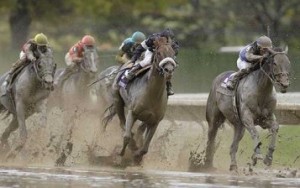Breeder’s Cup Results

The Breeder’s Cup is one of North America’s most important thoroughbreds meetings held annually around early November at one of the leading flat racecourses in the US. The Breeder’s Cup host some of the world’s best group 1 thoroughbred horses and is considered and world championship which is why the Breeder’s Cup results are an important factor in these top horse racing events.
Breeder’s Cup Results
The results of the 14 different races in the Breeder’s Cup meeting are something many bettors and horse owners alike wish to have some clue about as the Breeder’s Cup results define the payout of any Breeder’s Cup betting, and also sets the winning horses at the top of global group 1 thoroughbreds list as well as rewarding the winning owner with a handsome purse. Since the races of the meeting are being run by the best horses in the world, predicting the Breeder’s Cup results can be a very difficult task to achieve as they mighty ones battle one another in the race for the Breeder’s Cup. This makes Breeder’s Cup results a highly debated subject in the horse racing social forums and the professional horse racing community as horse racing fans, bettors and commentators argue over which horses might win the race or which are clearly underestimated and therefore could be of some value as they are overpriced. Previous years Breeder’s Cup results are also used in terms of analyzing past results and statistics for it might shed a bit of light on the possible results of the next Breeder’s Cup.
Significance of the Breeder’s Cup Results
The Breeder’s Cup results are of high Significance as they are the combined results of the 14 different races held in the meeting:
- Breeders’ Cup Marathon – 14 furlong (group III)
- Breeders’ Cup Juvenile Fillies Turf – 8 furlong (group II)
- Breeders’ Cup Filly & Mare Sprint – 7 furlong (group I)
- Breeders’ Cup Juvenile Fillies – 8.5 furlong (group I)
- Breeders’ Cup Filly & Mare Turf – 10 furlong (group I)
- Breeders’ Cup Ladies’ Classic – 9 furlong (group I)
- Breeders’ Cup Juvenile Turf – 8 furlong (group II)
- Breeders’ Cup Sprint – 6 furlong (group I)
- Breeders’ Cup Turf Sprint – 5 furlong (group II)
- Breeders’ Cup Juvenile – 8.5 furlong (group I)
- Breeders’ Cup Mile – 8 furlong (group I)
- Breeders’ Cup Dirt Mile – 8 furlong (group I)
- Breeders’ Cup Turf – 12 furlong (group I)
- Breeders’ Cup Classic – 10 furlong (group I)
Breeder’s Cup results for each of these races is an outcome predicted months prior to the meeting and all the way to the final days before the meeting is due which suggests just how much meaning these Breeder’s Cup results hold for many who fancy top class horse racing. Without the assumption over Breeder’s Cup results, no proper Breeder’s Cup betting can be conducted and so a great deal of effort is being put in this.
The Breeder’s Cup is one of North America’s most important thoroughbreds meetings held annually around early November at one of the leading flat racecourses in the US. The Breeder’s Cup host some of the world’s best group 1 thoroughbred horses and is considered and world championship which is why the Breeder’s Cup results are an important factor in these top racing event.
Breeder’s Cup Results
The results of the 14 different races in the Breeder’s Cup meeting are something many bettors and horse owners alike wish to have some clue about as the Breeder’s Cup results define the payout of any Breeder’s Cup betting, and also sets the winning horses at the top of global group 1 thoroughbreds list as well as rewarding the winning owner with a handsome purse. Since the races of the meeting are being run by the best horses in the world, predicting the Breeder’s Cup results can be a very difficult task to achieve as they mighty ones battle one another in the race for the Breeder’s Cup. This makes Breeder’s Cup results a highly debated subject in the horse racing social forums and the professional horse racing community as horse racing fans, bettors and commentators argue over which horses might win the race or which are clearly underestimated and therefore could be of some value as they are overpriced. Previous years Breeder’s Cup results are also used in terms of analyzing past results and statistics for it might shed a bit of light on the possible results of the next Breeder’s Cup.
Significance of the Breeder’s Cup Results
The Breeder’s Cup results are of high Significance as they are the combined results of the 14 different races held in the meeting:
Breeders’ Cup Marathon – 14 furlong (group III)
Breeders’ Cup Juvenile Fillies Turf – 8 furlong (group II)
Breeders’ Cup Filly & Mare Sprint – 7 furlong (group I)
Breeders’ Cup Juvenile Fillies – 8.5 furlong (group I)
Breeders’ Cup Filly & Mare Turf – 10 furlong (group I)
Breeders’ Cup Ladies’ Classic – 9 furlong (group I)
Breeders’ Cup Juvenile Turf – 8 furlong (group II)
Breeders’ Cup Sprint – 6 furlong (group I)
Breeders’ Cup Turf Sprint – 5 furlong (group II)
Breeders’ Cup Juvenile – 8.5 furlong (group I)
Breeders’ Cup Mile – 8 furlong (group I)
Breeders’ Cup Dirt Mile – 8 furlong (group I)
Breeders’ Cup Turf – 12 furlong (group I)
Breeders’ Cup Classic – 10 furlong (group I)
Breeder’s Cup results for each of these races is an outcome predicted months prior to the meeting and all the way to the final days before the meeting is due which suggests just how much meaning these Breeder’s Cup results hold for many who fancy top class horse racing.



